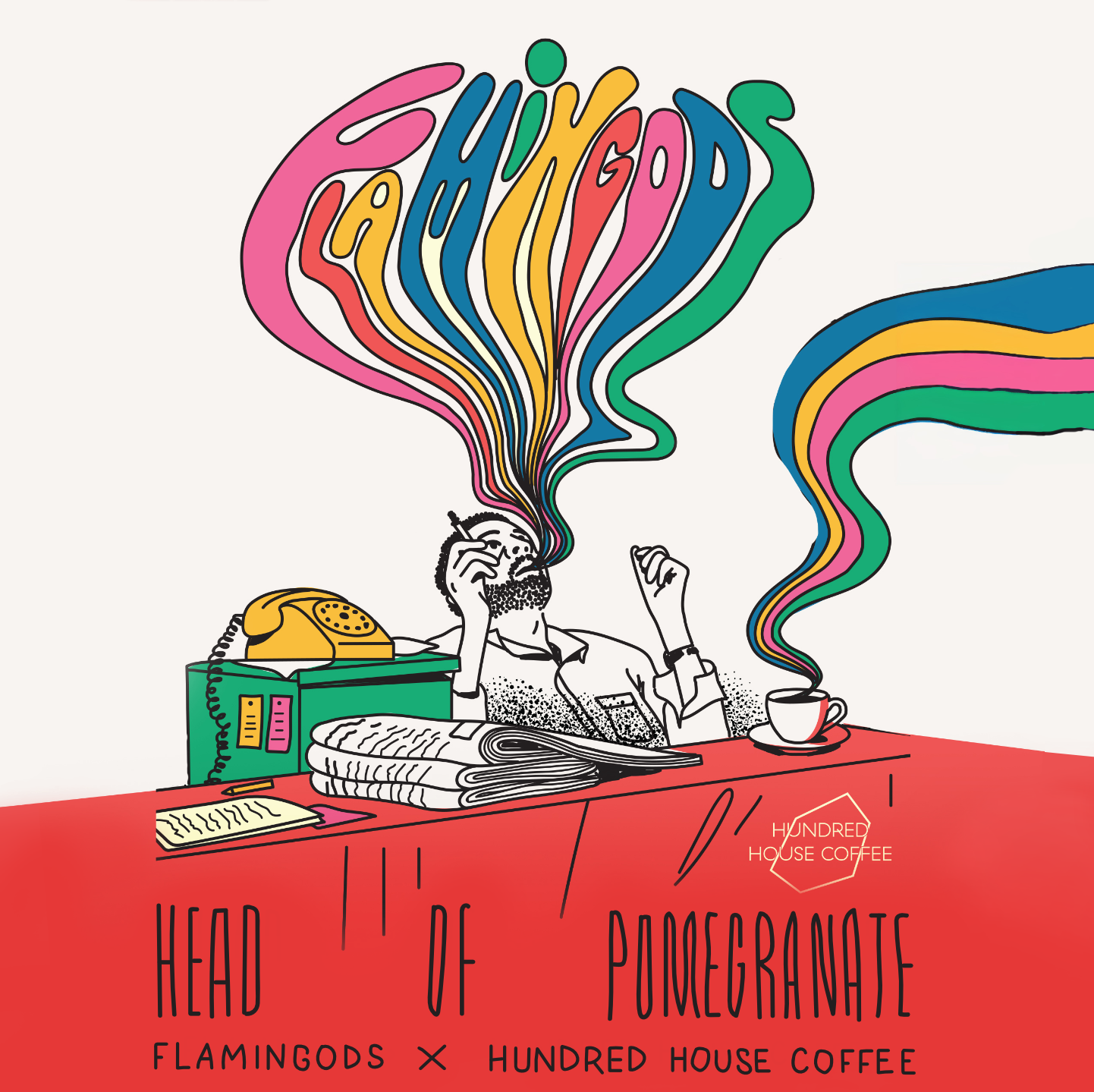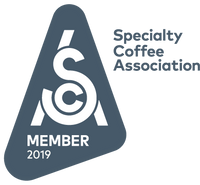
Music | Guest Mix! The Flamingods Head Of Pomegranate
Hundred House coffee has collaborated with psychedelic alternative rock band Flamingods.
Lead singer Kamal Rasool has put together a deep mix to celebrate, he sums it up beautifully...
I often use my mixes as ways to showcase cross cultural dialogues and relationships in sound. They’re a context within which I can explore cultures, societies, collective histories from different times and places, in an attempt to transcend borders and convey instead similarities in feeling, the undercurrents that knit diversity. I consider myself a cultural explorer, which is also a very important part of the band, Flamingods—cultural exploration and the drive to always seek out new knowledge and arts. I think this was a popular lifestyle, inherited from the 40s -70s but lately popular culture considers this approach 'weird' unless it's related to something like yoga.
I often feature music from the 60s and 70s in my mixes because I believe that in that time musicians were more open to searching far for influence and blending in different musical styles than they are now. You can see this in some of the tracks I featured such as the Batsumi track which mixes traditional South African music and instrumentation with afro-spiritual jazz and funk. You can also see it in the Francis Bebey track who mixes traditional flutes and hand drums with electronic bass and contemporary French vocal stylings.
The 60s and 70s - though a time for proposed peace and love in the world, was also, quite ironically, a time of revolution, violence and oppression. Some of these songs came out during times of great grief such as Batsumi's, which came out of Apartheid-era South Africa.
All the musicians on the mix look to the past for inspiration whilst creating something wholly new. Alice Coltrane in the 70s, was heavily influenced by ancient Hindu values and theology (even founding a Vedantic Center in California in 1975) whilst incorporating her signature spiritual jazz. There is also the modern example of Flying Lotus (the nephew of Alice Coltrane) who samples the past, often his aunt Alice's harp and incorporates electronic production, which is also a similar case with the Chancha Via Circuito track.
I really enjoy repetition in music as a form of hypnotism. A lot of the songs featured in the mix I consider hypnotic and easy to get lost in.
In the Bernard Estardy track I featured three interview clips from three dead musicians who I believe have something in common: Sun Ra, Fela Kuti and Jim Morrison. All three claimed to reach transcendental heights through their music, Sun Ra in particular claiming to channel 'the past, present and future' and even space. Fela Kuti looked to the past in his interpretation of ritualistic music, while his lyrics brought it to the present day, contemplating a better future. Jim Morrison saw himself more as a poet than a singer, and was heavily into ancient Vedic poetry. Again he gave these reflections on the past a futuristic outlook by setting it to contemporary rock music. Sun Ra even went as far as to claim he was from the planet Saturn, and that all black people also originated from this planet. He envisioned Saturn as a utopia for his fellow men and women. There is a film where his theory of Afro-Futurism is elaborated on, 'Space is the Place'.
The reason I featured three Exotica-genre songs in the mix: the closing three tracks from Les Baxter, Tito Puente and Eden Ahbez is because as a genre, Exotica's purpose is to transcend or conjure imagery of our distant past whilst maintaining modern instrumentation, which is in area of intrigue for me.
The message of the mix is to look to the past for inspiration, whilst also creating something new that flows coherently. The musicians included all unify different cultures with their own, marrying two different ideas together to create a new sound. Often this was due to a dissatisfaction with the current state of their own contemporary culture; be it politics, corruption, consumerism or capitalism. The artists here have all at some point used music as a means for idealising and creating their own concepts of utopia.
With this combination of artists, I’ve also tried to displace sounds – mixing the everyday with the instrument, for example Alice Coltrane’s harp and the material sounds of the Lucky Dragons – but also chronologically and geographically. By fusing it in this way, it ties in with these ideas of collaboration towards creation. For example with the Kaisai All Stars—a 25-piece musical collective based in Kinshasa, Democratic Republic of the Congo. The musicians originally come from five bands, all from the Kasai region, but originate from five different ethnic groups: the Songye, Lulua, Tetela, Luba, and Luntu. Some of these groups have endured conflicting relationships over the centuries, they each have their own culture, their own language and their own musical traditions, which were always thought to be incompatible until they decided to pool their resources and form a ‘superband’, at the instigation of Belgian producer Vincent Kenis. This rarely happens with visual art — and perhaps it is only possible through the immediacy, synergistic and embracing nature of music.

FOOTNOTES:
[1] Batsumi were an Afro-jazz outfit led by a blind guitarist, Johnny Mothopeng, along with his keyboard-playing brother Lancelot and bassist Zulu Bidi. They worked in the sprawling Johannesburg township in the early 70s, and their debut album was unobtainable for decades, until its re-release in 2011.
[1] Francis Bebey, born 1929 Douala, Cameroon – died 2001 in Paris, France. Bebey was a Cameroonian artist, musician, and writer. In the early 1960s, moved to France and started work in the arts, establishing himself as a musician, sculptor, and writer. Bebey released his first album in 1969. His music was primarily guitar-based, but he integrated traditional African instruments and synthesizers as well. His style merged Cameroonian makossa with classical guitar, jazz, and pop. He sang in Duala, English, and French. He released more than 20 albums over his career.
[1] Alice Coltrane, born 1937, Detroit, Michigan – died Los Angeles 2007. Coltrane was an American jazz pianist, organist, harpist, and composer, and the second wife of jazz saxophonist and composer John Coltrane. One of the few harpists in the history of jazz, she recorded many albums as a bandleader, beginning in the late 1960s and early 1970s. Coltrane studied classical music, and also jazz with Bud Powell in Paris, France, where she worked as the intermission pianist at the Blue Note Jazz Club in 1960. She began playing jazz as a professional in Detroit, with her own trio and as a duo with vibist Terry Pollard.
[1] Steven Ellison, born 1983, Los Angeles, known by his stage name Flying Lotus. He is an experimental multi-genre music producer, electronic musician and rapper. Ellison is the grand-nephew of the late jazz pianist Alice Coltrane, and her husband saxophonist John Coltrane. Additionally, he is the grandson of singer-songwriter Marilyn McLeod. In 2007, Ellison signed with Warp Records (home to Prefuse 73, Autechre, Squarepusher and Aphex Twin - he quickly became one of the label's cornerstone artists.
[1] Pedro Canale, born Buenos Aires, Argentine known by his stage name Chancha Vìa Circuito. Canale is a producer, DJ/remixer and composer. His work explores various Latin American musical influences, including folklore music, reggae, cumbia sonidera, Colombian cumbia, Peruvian cumbia and cumbia villera. He has been producing instrumental music, fusing electronic with acoustic instruments and voices since 2005.
[1] Bernard Estardy, born 1939 in Charenton-le-Pont, France—died in 2006, nicknamed The Baron (Baron Mehouilles). Estardy was a musician and producer. He began, after graduate studies at the ESTP, as a musician (organ, piano, bass) alongside Nino Ferrer (bass) in the group that accompanied Nancy Holloway, with Georges Chatelain as the guitarist. In 1966, he created the recording studio CBE (Chatelain-Bisson-Estardy) with Georges Chatelain and Bernard Bisson.
7 Sun Ra (born Herman Poole Blount), 1914, Birmingham, Alabama—died in 1993, Birmingham, Alabama. Sun Ra was an American jazz composer, bandleader, piano and synthesizer player, poet and philosopher known for his ‘cosmic philosophy’, prolific musical output, and performances. Controversial because of his eclectic music and unorthodox lifestyle, and claiming that he was of the ‘Angel Race’, and not from Earth but from Saturn, Sun Ra developed a complex persona, using cosmic philosophies and lyrical poetry that made him a pioneer of Afrofuturism. From the mid-1950s to his death, Sun Ra led ‘The Arkestra, an ensemble with an ever-changing name and flexible line-up, although certain core members remained with the group through its various incarnations (Marshal Allen, John Gilmore, June Tyson, and others). His mainstream success was limited, but he was a prolific recording artist and frequent live performer. His music ranged from keyboard solos to big bands of over 30 musicians and touched on virtually the entire history of jazz, from ragtime to swing music, from bebop to free jazz. He also used free improvisation and was one of the early musicians to make extensive use of electronic keyboards.
[1] Fela Kuti (born Olufela Olusegun Oludotun Ransome-Kuti) 1938 in Abeokuta, Ogun State, Nigeria—died 1997, Lagos. Fela Kuti was a Nigerian multi-instrumentalist, musician, composer, pioneer of the Afrobeat music genre, human rights activist, and political maverick.
[1] James Douglas Jim’ Morrison, born in Melbroune, Florida—died 1971, Paris, France. Morrison was an American singer, poet and songwriter best remembered as the lead vocalist of the Doors. Due to his songwriting, baritone voice, wild personality and performances, he is regarded by critics and fans as one of the most iconic and influential frontmen in rock music history. In the latter part of 20th century he was one of popular culture's most rebellious and oft-displayed icons, representing generational gap and youth counterculture.
[1] ‘Space Is the Place’ is an 85-minute blaxploitation science fiction film made in 1972 and released in 1974. It was directed by John Coney, written by Sun Ra and Joshua Smith, and features Sun Ra and his Arkestra. A soundtrack was released on Evidence Records.
[1] Les Baxter, born 1922—died, 1996, California. Baxter was a musician and composer and alongside Martin Denny and Arthur Lyman, is celebrated as one of the progenitors of exotica music.
[1] Ernesto Antonio "Tito" Puente, born 1923, New York—died 2000, New York. He was an American salsa musician and Latin jazz composer of Puerto Rican descent. Puente is best known for dance-oriented mambo and Latin jazz compositions.
[1] George Alexander Aberle, known as eden ahbez, born 1908—died 1995, Los Angeles. Ahbez was an American songwriter and recording artist of the 1940s to 1960s, whose lifestyle in California was influential on the hippie movement. Ahbez composed the song Nature Boy, which became a No. 1 hit for eight weeks in 1948 for Nat ‘King’ Cole and has since become a pop and jazz standard. He chose to spell his name with lower-case letters, claiming that only the words God and Infinity were worthy of capitalization.
[1] Kasai All Star band line up: Mputu Ebondo 'Mi Amor'-lead vocals; Muambuyi-lead vocals, dancer; Mbuyamba Nyunyi-lead vocals, bass likembe; Kabongo Tshisensa-lead vocals, likembe, bass likembe; Tandjolo-lokole (slit drum), lead vocals; Tshilumba Muamba; 'Baila' and Didi Bafuafua-xylophones; Tshimanga Muamba-resonator drum; Kalenga Ditu-likembe (thumb piano); Mopero and Niawu-electric guitars; Kabese Ngandu 'Bondis'-vocals, percussion; Ngalula Ndaye Sylvie, Bosio Tokala Mamie, Yempongo Kadiya,; Tete Mutungilayi and Kanku Nshinga Wa Buanda-vocals and dancing; Mpanya Mutombo-lead vocals; Gaby Nsapo Kilolo-guitar and vocals.
Tracklist (song name - artist):
- A Love Supreme (Excerpt) - Alice Coltrane
- Soul Vibrations - Dorothy Ashby
- Sanza Tristesse - Francis Bebey
- Coplita - Chancha Via Circuito ft. Miriam Garcia
- Tarot Will Teach You / Burn Your Money - Alexandro Jodorowsky & Don Cherry
- Field Recordings / Dream Scene (Excerpt) - George Harrison
- Clay - Flying Lotus
- Cerebellum - Hear Hums
- Asiatic Dream - Bernard Estardy / Interview Excerpts; Sun Ra, Fela Kuti & Jim Morrison
- Mamshanyana - Batsumi
- Starter Culture - Lucky Dragons
- Quick As White - Kasai Allstars
- Sunrise - Magic Fingers
- Oasis of Dakhla - Les Baxter
- Call Of The Jungle Birds - Tito Puente
- Full Moon - Eden Ahbez
Artwork is created by Toucan Tango. Toucan Tango are screen-printing duo Luce and Scott - "we create original artwork conjured out of taking joy in simple, every day pleasures, whether they be a cracking cuppa, a weekend ramble in the Welsh hills or listening to a new record on repeat."




